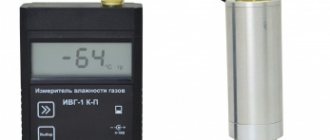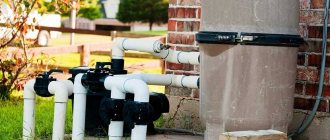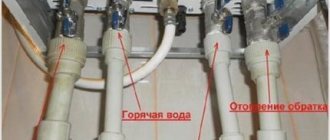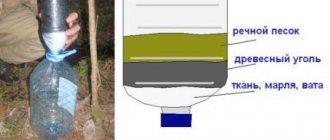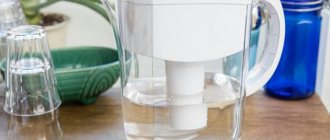Lately the environment has been getting worse. Against this background, the level of water quality has dropped significantly. All this creates the need to buy household filters for water purification. A water filter is really necessary because it helps to obtain water that is suitable for drinking according to all norms and standards. The water that runs through our pipes is far from ideal and may well be hazardous to health. Therefore, if you have the opportunity to purchase a filter, I strongly advise you to do so.
The quality of water filtration depends directly on the type of filter used for filtration. In order to get the highest quality water, you need to choose the right filter. To do this, you need to do an analysis of the water that you are going to filter, and also understand the mechanism of the filter. It is necessary to study the mechanism of operation of the filter in order to better understand how exactly water purification occurs, and based on this, make an informed choice.
How does a pitcher filter work?
A jug-type filter is a structure that consists of two main elements. First of all, it is a large container into which a smaller container is inserted. From a smaller container, water flows through the cartridge and enters the container located below. Thus, the container below contains clean water, which we can use for drinking and cooking.
The mechanism of the filter is simple. Under the influence of gravity, water flows from one vessel to another. It is this phenomenon that contributes to water filtration. The filter element is filled with a special filler, which makes it possible to purify water. The filler is selected based on the quality of tap water.
Device
The structure of the water filter jug is quite simple. It includes two containers of different sizes, between which there is a filter element.
A jug is a container for collecting purified liquid. As a rule, it is made of high-quality shockproof plastic and can have a volume of 1.5 to 4 liters.
A special funnel is inserted into the jug into which water is poured for filtration. As a rule, it is of a smaller volume, so to clean a large amount of liquid it should be added gradually.
The main element of the system is a cartridge that filters water. It can be of different types depending on the type of cleaning composition.
- Classical. It is used to purify tap water from chlorine, heavy metals and organic compounds. It effectively removes unpleasant taste and odor from liquid.
- With fluoridating components. In addition to classical functions, it saturates water with fluoride in a concentration beneficial to the body.
- Softening. Eliminates water hardness.
- With filter elements to reduce iron levels. Relevant for regions where there is an increased concentration of iron-containing impurities in the water.
- With bactericidal elements. Effectively destroys harmful bacteria, such as E. coli.
All cartridges are equipped with a special membrane that traps large elements.
The filling of the cartridges is also different. Most models use classic sorbents - activated carbon, polypropylene fibers or ion exchange resin.
Many cartridges are equipped with a mechanical calendar. When installing a new filter, enter the month the replacement occurred. This way you will control the duration of its operation and will be able to replace it in a timely manner. Some innovative models have a built-in electronic indicator that indicates the exhaustion of the cartridge and reminds you of the need for replacement.
The filter is designed in such a way that the two liquids never mix. Don't worry about untreated water getting into the cup or main reservoir when you tilt it. The jug is closed with a special lid that protects the water from dust and other contaminants.
Should I use stationary filters for water purification?
Stationary filters have larger dimensions than the two previous options. The mechanism of operation of this type of filter directly depends on the filter material that is installed on it. As a rule, the essence of the filter’s operation comes down to the fact that it passes water under pressure through the filter element, which helps clean it. It is worth noting that stationary filters are connected to the water supply using a flexible hose. Also, if you are going to purchase such a filter, you should know that it will take up a certain place in your kitchen. You can purchase special mounts and hang the filter on the wall.
The design feature of this filter compared to the previous ones is that it has a container for storing filtered water and a faucet with which you can receive this water. The speed of this filter is higher than the previous two models, but it is still slow compared to more expensive models.
The advantage of such a filter is that it does not require too much pressure in the water supply network. Thus, even if your apartment is on the upper floors of a multi-story building, you can still get clean water without the need for additional equipment.
Myths
Among users of filtering systems there are always skeptics who claim that water after cleaning becomes tasteless, unhealthy, and even wastewater pollutes the environment. Let's try to dispel such guesses.
Reverse osmosis flushes out the minerals our bodies need.
The liquid that comes into our tap contains many useful mineral inclusions, however, the percentage of them is so small that it cannot have any effect on our health. But the content of heavy particles indigestible by the body is quite impressive. For those who want to receive more micro and macroelements, it is better to consider a balanced diet.
A large number of drains
To wash the membrane, some of the water is actually used, which makes it possible to replace the expensive component several times a year and keep the system clean. Sewage is discharged into the sewer system, but is quite purified and can be used for irrigation and other domestic needs.
Nobody needs pre-filters
The main filter element is sensitive to high contents of chlorine, iron and organics, so mechanical cleaning leads to a reduction in the volume of these products to acceptable levels, ensuring the correct operation and durability of the purifier.
This H2O is absolutely tasteless, lifeless
There is no clear confirmation of this statement. When a person drinks liquid from the tap for several years, he gets used to its taste. In comparison with chlorinated tap water or sweetish iron-containing water, it really can be considered “empty”. It also does not have the metallic aftertaste associated with well water. However, many note the similarity with thawed milk, which is the standard of quality. This effect is achieved by using a carbon filter.
Filtered composition spoils teeth
The membrane, along with various impurities, also separates fluoride, which is necessary to strengthen tooth enamel. Will the lack of calcium gradually lead to tooth decay? In theory yes, but in practice no. For more than 30 years, scientists have been conducting research in this area and not a single patient has yet developed problems with the oral cavity while consuming distilled H2O.
Too expensive a purchase
If we talk about the initial installation of the system, the cost will be around 20,000 rubles. Further, it is necessary to change the filter elements twice a year, post-filters and the membrane unit - once a season. The price for consumables will be about 5,000 rubles. It turns out to be a decent amount, which makes you think about the need to purchase. However, calculate the amount of consumption per year (minimum 2 liters per day and 700 liters) and it turns out that a liter costs about 50-60 kopecks. It is unlikely that you will find a bottled version in the store for that kind of money. Plus, you will be confident in the quality of the product purified by our own system.
AMETHYST - 02 M up to 2 cubic meters/day.
Aeration unit AS-1054 VO-90
Main table dispenser AquaPro 919H/RO (hot and cold water)
What is special about sink filters?
Under-sink filters differ from all of the above options in that they save space in the kitchen due to direct connection to the water supply network. Also, such a filter is good because it leads to a special tap in the kitchen on the sink or countertop, from which you can get purified water.
Filters that are installed under the sink have a very great potential for water purification. This is due to the fact that filtration takes place in several stages. The more of these stages, the higher the water quality. For example, there are filters for washing that operate on the principle of 5-stage cleaning. This is the maximum number of purification stages that gives water quality very close to what can be obtained from a reverse osmosis filter.
The principle of operation of the filter is that each stage of cleaning is assigned a specific mission. For example, the first stage of purification removes mechanical impurities from the water, then the water goes to the next stage of purification. The second stage of purification removes smaller particles from the water, it all depends on which filter element is installed in the second stage of water purification. This can be an ion exchange resin, various membranes and other filter elements.
For this system to operate, one condition must be ensured: sufficient pressure in the water supply network. Using this filter may cause problems for residents on the upper floors of multi-storey buildings, since there, as a rule, the water pressure is much lower than on the first floors and much lower than the operating conditions of the filter require.
Criterias of choice
When choosing a filter pitcher, consider several important features.
Material. Give preference to a product that is made of durable and high-quality plastic. Safety is evidenced by the presence of special markings indicating the use of food-grade polymer. Reliable and safe material will ensure long-term operation and protect household members from a number of diseases.
Be sure to smell the jug before purchasing. If it emits a sharp and unpleasant smell of plastic, then this is a sure sign of using a low-quality polymer. Avoid this purchase.
When purchasing a water filter jug, make sure that replacement cartridges for your model are readily available.
Volume. This criterion depends on the need for drinking water and the number of family members.
Cartridges. It is important to pay attention to three factors: the type of filter element, the type of cleaning media and the possibility of purchasing a replacement cartridge. Select it based on water quality. For example, for a hard liquid, a softening agent is suitable, and for a liquid that has not undergone preliminary antibacterial cleaning, a bactericidal one is suitable. To identify the main contaminants, water samples will have to be taken.
When purchasing a jug, be sure to make sure that there are replacement cartridges available on the market that are suitable for your model.
Design. All models are made in the form of a jug, but they may differ in color and design. The choice of this criterion is an individual decision for everyone and depends on taste preferences and color scheme of the kitchen.
Which filter is better?
It is quite difficult to answer this question, since the choice of filter should be based purely on the individual needs of a person. Also, the choice of filter depends on financial capabilities; for complete water purification, you can also buy a filter based on reverse osmosis, but not everyone can afford it. Therefore, when choosing a filter, consider your own water needs. Using this approach, you will always have only clean, fresh and healthy water in your home.
Watch the video film: “How does a water filter work?”:
Principle of operation
The principle of operation of a water filter jug is quite simple. Liquid is poured into the funnel and passes through the cleaning element. The filtered water flows into a jug where it is stored.
Due to the fact that the sorbent in the cartridge is in powder form and not compressed, the cleaning process takes place quite quickly, and water does not linger in the tank for a long time. As you filter, add fresh water to the funnel. This will ensure a constant supply of clean drinking moisture.
Well pump
After drilling a well, we think about buying a pump (and generally before). A water purification system for a private home, cottage or summer house begins with a well and a pump. A borehole pump supplies water from a well or well (autonomous water supply) to a water treatment system (storage tank or accumulator) passing through a mesh mud filter.
Well pump from ZDS
The choice of pump depends on:
- from the depth of the well;
- on the required performance;
- from your budget.
Practice shows that the most popular from the middle price segment are such manufacturers as ZDS and Italian pumps Pedrollo and Lowara.
Budget options include Whirlwind, HAMMER, QUATTRO and others. But a well pump is not an element worth saving on. And here is a simple approach - it’s better to spend money once and forget for several (ideally several decades) years.
GRUNDFOS and FORWARD pumps are also popular. The price for GRUNDFOS is usually higher, but I didn’t notice much of a difference (if we take into account pumps that have the same technical characteristics).
We will talk about the general choice of a borehole pump in a separate article.
The average budget for a well pump is 30,000 rubles.
For a system with a capacity of 2 cubic meters per hour, you need to select a pump as follows.
We find an online store for pumping equipment. Let's go to the pumps section - well pumps. We set the minimum productivity in the filter - 2000 liters per hour, maximum - 3000 liters per hour.
Open the card of the pump that you like. Open the documentation (passport, instructions, etc.).
Graph of pressure characteristics of a well pump
We find a graph of pressure characteristics. In the graph, we find the maximum productivity at the pressure height we need (add the depth of the well and the distance the water rises after the well), and look at the productivity indicator.
If, at the required height, the efficiency of the pump is at the point of the required performance, then this model is suitable for us.
Pumping station
The pumping station is designed to maintain constant water pressure in the water supply system. The pumping station usually operates in fully automatic mode. And it only requires initial setup.
DAB pumping station
A middle-class pumping station will cost you 30,000 rubles. But here you can save a lot if you need a low-performance system.
You can select a station according to the required productivity (we have 2 cubic meters per hour).
After the pumping station, the water enters the aeration column.
Installation
It is quite possible to install such a purification system yourself. Just read the instructions carefully and take the necessary tools for installation.
Filters designed to purify hot water belong to the universal category. If necessary, they can be installed in a cold water supply system.
If systems for cold and hot water are purchased, each of them should be installed strictly in its own line. This is important for high-quality cleaning and long service life of the entire device.
Before installation, you need to turn off the water and remove the pressure from the pipes. To do this, just open one of the taps where the main line is planned to be installed.- On the wall where the filter will be installed, it is necessary to apply markings to mark the place where the flask mount will be fixed. All dowels are always included with the system. Therefore, the drill should be selected taking into account the size of the fastening.
- After drilling the holes, a dowel is driven into them. After this, you need to take the filter and place it on the dowel, tightening the screws from the kit with a screwdriver or screwdriver. The holes for fixing to the dowel are located in the upper part of the flask.
- There are special tubes on both sides of the filter for connection to the main water supply. To connect them, the water pipe is cut with special pliers on the left and right sides. After this, the supplied clamps are inserted into them, which connect the filter and the pipe. These parts must be strengthened with a clamping nut. For reliability, they can be wrapped with FUM tape, which guarantees complete sealing of the system.
- If several stages are installed at once, they should be connected in the same way as with a pipe - a clamping nut. In this case, be sure to seal all joints.
- After connecting, you need to check the line for leaks. To do this, open the water and check the entire system. If there is no leak, leave the tap open for 5-7 minutes. This is required to flush the cartridge and release accumulated air from the pipes.
Expert opinion
Koklyaev Vladimir Stepanovich
Experienced plumber with 12 years of experience
To minimize unpleasant consequences in the event of a leak, it is better to place a sufficient amount of rags under the line. In case of leaks, she will be able to collect water and prevent flooding of her neighbor’s and her apartments.
Osmosis and reverse osmosis - a little theory
First, briefly about what reverse osmosis is and why the water purification process has such a name. Osmosis is simply a natural mechanism for saturating solutions with necessary substances. Every cell in the body has a membrane that allows water molecules to pass through. But, as it turned out, water passes only if other substances are dissolved in it. At the same time, the membrane allows only water molecules to pass through and retains dissolved substances. This phenomenon is called osmotic pressure. The principle of its operation is clearly shown in the following photo.
The principle of operation of osmotic pressure Source cf.ppt-online.org
Figure “a” shows a liquid in which particles of a certain substance are dissolved. The vessel containing the liquid is separated by a partition with a membrane. On the left, the concentration of the solution (the number of particles of the dissolved substance) is 180 g/L, and on the right - 360 g/L. Therefore, osmotic pressure begins to act, which squeezes the liquid through the membrane from the left side of the vessel to the right. This happens until the concentration (density) of the solution in the left and right parts is equalized, which is shown in figure “b” - we see that on both the left and right this value has become 270 g/L.
But if in one part of the vessel a pressure is artificially created that exceeds osmotic pressure, then the liquid will be squeezed out into that part of the vessel where the pressure is less - this process is called reverse osmosis. Essentially, this is forcing a liquid through a membrane, the size of the holes in which does not exceed the size of the molecules of this very liquid. In addition to the fact that the particles dissolved in the liquid are much larger than molecules, the reverse osmosis system allows even viruses and bacteria to be retained on the membrane.
Advantages and disadvantages
So, having figured out reverse osmosis - what it is, let’s move on to the pros and cons of the device.
Let's start with the fact that many consumers are scared by the fact that the water coming out of the filter is very clean. That is, it does not contain the required presence of nutrients. That is why a mineralizer was installed, although it is not present in all models. That is, the problem is solved. At the same time, the water passing through the minerals acquires a pleasant taste.
But it should also be noted that the purest water does not cause any harm to humans. In addition, it will contain a minimal amount of viruses and bacteria. And this is a big plus.
There are industrial plants that desalinate sea water. And they contain reverse osmosis technology. It is clear that this cannot be done with a household appliance, but this proves that the efficiency of this type of filter is very high.
Industrial reverse osmosis filter for water desalination Source eurowater.ua


